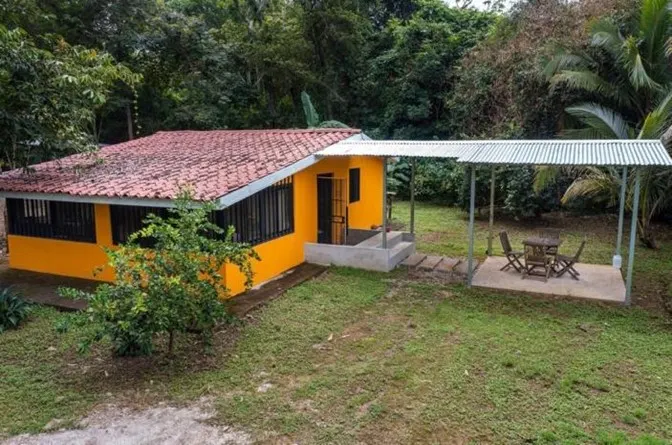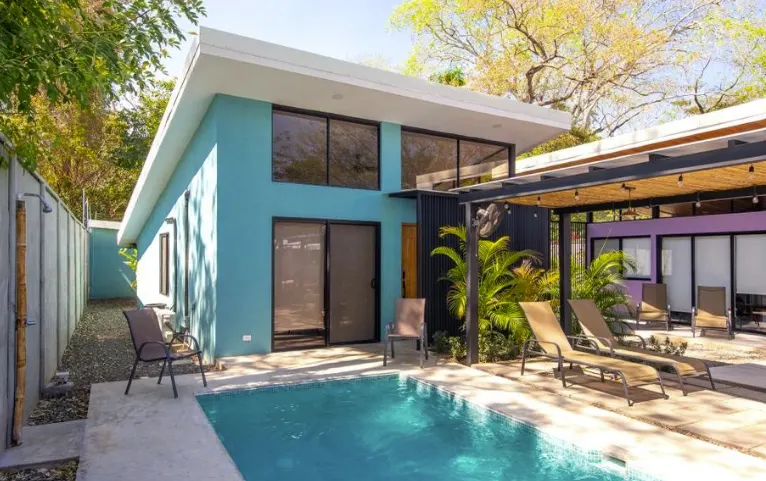On a walk through the neighborhood of Surfside in Guanacaste, Costa Rica, my husband James and I stumbled upon a sprawling, overgrown property separated from the jungle by an old barbed-wire fence. Mango trees had taken over. But peeking out from the brush was a small, sweet-potato-colored concrete tico house called Casa Camote.
James and I were in Costa Rica on a scouting trip for our next home. We’d envisioned a small, comfortable place with a casita on the property to rent out. As traveling freelancers doing everything from writing to YouTubing, we dreamed of a place that would welcome other like-minded people: digital nomads, clients, and roaming retirees.
When we discovered the tico house, even rundown as it was, we couldn’t deny our excitement… and the feeling of familiarity.
We’d only been in the country two days, but we’d found our future home.
Get Your Free Costa Rica Report Here
Get Your Free Costa Rica Report Here
Learn more about Costa Rica and other countries in our daily postcard e-letter. Simply enter your email address below and we’ll send you a FREE REPORT - Explore the Old World in Laidback Costa Rica.

By submitting your email address, you will receive a free subscription to IL Postcards, Overseas Dream Home, The Untourist Daily and special offers from International Living and our affiliates. You can unsubscribe at any time, and we encourage you to read more about our Privacy Policy.
A Vacation Turns Into an Overseas Move
At 60 and 61 years old, after four black-swan events during our careers—the dotcom bust, 9/11, the recession, and then the pandemic—we were done. Cooked. Over it.
The thought of living through one more event and growing old in the US made us weigh the comforts of home against the allure of a new beginning.
Our initial plan was to explore different places in Costa Rica, starting with Potrero Surfside in Guanacaste. We were drawn to Costa Rica for the lower cost of living (we could buy outright, so no mortgage), tropical climate, beaches, proximity to the US, excellent healthcare, democratic government, lack of military, and its commitment to the planet.
But after discovering Casa Camote, we never left Surfside. Surfside is a beachside neighborhood with walkable dirt roads, restaurants, a brewery, and grocery stores. Plus, it was close to Liberia airport, had good medical clinics, and a diverse community of North Americans and ticos.
Casa Camote, at 20 years old, was run down. But at nearly 8,000 square feet, the property had plenty of room to build. We made an offer, comforted by the 15-day rescind period.
Fast forward two and a half years, and we’re living in our newly constructed 900-square-foot home, Casa Wabi Sabi, complete with a pool. Camote has been remodeled into the rentable two-bedroom "Casita" Wabi Sabi—a welcoming home for travelers, adventurers, and digital nomads.

As you can imagine, the transition wasn’t without hurdles—and some tears. Building Casa Wabi Sabi brought challenges that tested our resolve and our relationship. But our new home and rental unit are the cornerstone of the lifestyle we enjoy today.
Here’s how we did it—and lessons (lovingly called an AFOG—Another Freakin’ Opportunity to Grow) we learned along the way, so you don’t have to.
Embrace Wabi Sabi
Here’s a slice of humble pie: working in a different country, with its unique cultural norms, language barriers, and unfamiliar building processes, meant relearning much of what we thought we knew.
We’d felt well prepared as we started our construction journey, having built two homes and remodeled one in the US. But we quickly learned that experience doesn’t always translate across borders.
There’s no way not to find yourself on a learning curve if you plan to build abroad. Despite stumbling around, we adapted, succeeded, and maintained our spirits (and marriage).
To do so, we embraced the philosophy of wabi sabi: the Japanese aesthetic tradition of accepting transience and imperfection.
This principle guided us not just in our construction project, but in maintaining a mindset that accepts the ups and downs of life. There is no "normal" living abroad—especially in a culture that doesn’t resemble the way of life you’re used to.
Verify Local Norms Around Business Practices
Although our architect and engineer assured us they "knew people" (a common phrase in Costa Rica) and could handle the municipal permissions informally, this approach led to a seven-week delay.
Construction began without the necessary permits, a decision guided by local practices we were initially told was standard. Then, one day, the Muni showed up and shut the job down due to lack of a permit. All workers dropped their tools where they stood and walked off the job.
This incident painfully reminded us of the need for due diligence and following local regulations… no matter the reassurances given by those who seem well-connected.
Practice Hypervigilance With All Project Details
Our architect spoke English, but we quickly learned that fluency in a language doesn’t guarantee understanding and meeting expectations.
For instance, there aren’t any inspections while building. Luckily, because of our proximity to the building, we could see when things were done wrong… most of the time. We caught bad paint jobs, and had to correct the wrong locations for lightboxes and switches.
Additionally, Costa Ricans generally avoid conflict and rarely say "no" directly, which made it challenging to address issues when the work was done poorly or didn’t meet our expectations.
Reacting as we would in the US wasn’t effective; we had to adapt to the local way of resolving problems with patience and diplomacy.
Living at the construction site allowed us to monitor the day-to-day operations closely, which was invaluable. This proximity enabled us to:
Respond quickly to any issues
Ensure that we were involved in the decision-making process
Catch anything done wrong
Question the abilities of workers. For example, the ditch digger being the plumber and the electrician being, well… questionable.
Many days included us making a call or sending an email with our observations and requests for corrections, or arranging a meeting to discuss a situation.
We recommend only building if you’re nearby or have someone you trust watching out for your best interests throughout the project. Be responsible for the building you want, rather than blaming another culture for its way of doing things. If you live in Costa Rica, then it’s up to you to learn the locals’ ways and act with kindness.
Implement a Structured Payment Schedule
We learned the importance of establishing a payment schedule from the project’s outset. Ensure the payments are aligned with milestones and deliverables so payments are made in installments. This isn’t a norm in Costa Rica, so hold your ground.
Toward the end of our construction project, we encountered several issues that required resolution before considering the project complete. Our pool and pool deck were done terribly, and we ended up hiring another company to finish the pool lining.
Due to this less-than-satisfactory work, we withheld a significant portion of the payment—approximately $10,000—as leverage to ensure that all our concerns were addressed adequately. After reviews based on our thorough tracking and final adjustments to our satisfaction, the outstanding amount due was reduced to $2,203. We settled this final payment only once we were confident that every aspect of the project met our standards before officially closing it.
At Home in Casa Wabi Sabi

We finished our casa in December 2022. We painted it the vibrant colors of a Costa Rican sunset: colorful, bright, and welcoming. The tropic charm makes our home a special place for us and visitors.
One of the things we love most about our home is its peaceful ambiance. We’re always surrounded by the sounds of nature, including the calls of howler monkeys, which wake us each morning. We cool down at the pool, or at the beach that our dogs love (before we even met some of our now-friends, they knew us as "The Poodle People" from seeing us on our walks).
Coming here has allowed us to lead a less stressful life. Conversations here tend more towards living fully, rather than focusing on work or politics, and foster a community atmosphere. What truly binds us to our expat community is a shared sense of courage, resilience, and adventure. We expats find strength and camaraderie in knowing that we all made the bold choice to embrace a new life.
We have the best of everything we ever wanted. We live in a beautiful place and make an income, working where, when, and how we want. What we’d dreamed of is now our reality. And best of all, our project lets us meet new folks… and gives people like us a place to call home.
Get Your Free Costa Rica Report Here
Get Your Free Costa Rica Report Here
Learn more about Costa Rica and other countries in our daily postcard e-letter. Simply enter your email address below and we’ll send you a FREE REPORT - Explore the Old World in Laidback Costa Rica.

By submitting your email address, you will receive a free subscription to IL Postcards, Overseas Dream Home, The Untourist Daily and special offers from International Living and our affiliates. You can unsubscribe at any time, and we encourage you to read more about our Privacy Policy.
